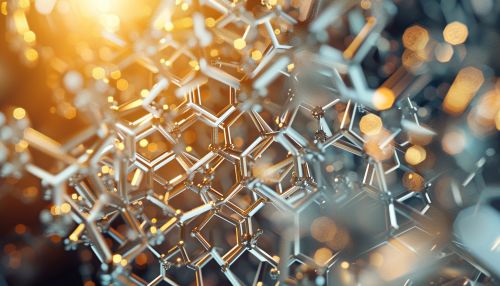Crystallographic Balance
Introduction
Crystallographic balance is a concept in crystallography that refers to the equilibrium state of a crystal structure, where the forces acting on the atoms are balanced, resulting in a stable and symmetrical arrangement. This concept is fundamental in understanding the properties and behaviors of crystalline materials, which are essential in various scientific and industrial applications. Crystallographic balance encompasses several aspects, including lattice symmetry, atomic interactions, and the influence of external conditions such as temperature and pressure.
Lattice Symmetry
Lattice symmetry is a key component of crystallographic balance. A crystal lattice is a three-dimensional arrangement of atoms, ions, or molecules in a repeating pattern. The symmetry of this lattice determines the overall structure and properties of the crystal. There are 14 distinct Bravais lattices, which are categorized into seven crystal systems: cubic, tetragonal, orthorhombic, hexagonal, trigonal, monoclinic, and triclinic. Each crystal system has its own unique symmetry elements, such as rotation axes, mirror planes, and inversion centers.


The symmetry of a crystal lattice is described by its space group, which combines the lattice symmetry with the symmetry of the atomic arrangement within the unit cell. There are 230 unique space groups, each representing a different combination of symmetry elements. The space group of a crystal provides valuable information about its physical properties, such as optical behavior, electrical conductivity, and mechanical strength.
Atomic Interactions
The stability of a crystal structure is determined by the interactions between its constituent atoms. These interactions include ionic, covalent, metallic, and van der Waals forces. The balance of these forces dictates the arrangement of atoms within the crystal lattice and influences the overall crystallographic balance.
Ionic Crystals
Ionic crystals are formed by the electrostatic attraction between positively and negatively charged ions. The strength of this attraction depends on the charges of the ions and the distance between them. The arrangement of ions in an ionic crystal is such that it maximizes the attractive forces while minimizing the repulsive forces. Common examples of ionic crystals include sodium chloride (NaCl) and magnesium oxide (MgO).
Covalent Crystals
Covalent crystals are characterized by the sharing of electrons between atoms, resulting in strong directional bonds. These bonds create a rigid and stable lattice structure. Diamond and silicon are examples of covalent crystals, where each atom is covalently bonded to several neighboring atoms, forming a three-dimensional network.
Metallic Crystals
Metallic crystals consist of a lattice of positively charged metal ions surrounded by a "sea" of delocalized electrons. This electron cloud allows for the free movement of electrons, giving metallic crystals their characteristic properties such as electrical conductivity and malleability. Examples of metallic crystals include copper, gold, and aluminum.
Van der Waals Crystals
Van der Waals crystals are held together by weak intermolecular forces known as van der Waals forces. These forces arise from temporary dipoles created by the movement of electrons. Van der Waals crystals typically have lower melting points and are softer compared to ionic, covalent, and metallic crystals. Examples include solid noble gases like argon and molecular crystals like iodine.
External Conditions
The crystallographic balance of a crystal structure can be influenced by external conditions such as temperature and pressure. These conditions can alter the atomic interactions and lattice symmetry, leading to phase transitions and changes in the crystal's properties.
Temperature
Temperature affects the kinetic energy of atoms within a crystal. As temperature increases, the atoms vibrate more vigorously, which can disrupt the crystallographic balance. At high temperatures, some crystals may undergo phase transitions, where the crystal structure changes to a different form. For example, quartz (SiO2) transforms from a low-temperature alpha phase to a high-temperature beta phase at around 573°C.
Pressure
Pressure can also impact the crystallographic balance by compressing the crystal lattice and altering the atomic interactions. High pressure can induce phase transitions, resulting in the formation of new crystal structures with different properties. For instance, graphite (a form of carbon) can transform into diamond under extreme pressure and temperature conditions.
Applications
Understanding crystallographic balance is crucial for various scientific and industrial applications. It plays a significant role in materials science, mineralogy, chemistry, and physics. Some key applications include:
Materials Science
In materials science, the crystallographic balance of a material determines its mechanical, electrical, and thermal properties. By manipulating the crystal structure, scientists can develop materials with specific characteristics for use in electronics, aerospace, and construction.
Mineralogy
In mineralogy, the study of crystallographic balance helps in identifying and classifying minerals. The crystal structure and symmetry provide valuable information about the formation conditions and potential uses of minerals.
Chemistry
In chemistry, crystallographic balance is essential for understanding the behavior of chemical compounds. The arrangement of atoms within a crystal lattice influences the reactivity, stability, and properties of compounds, which is critical for designing new materials and pharmaceuticals.
Physics
In physics, the study of crystallographic balance contributes to the understanding of fundamental phenomena such as superconductivity, magnetism, and optical properties. The symmetry and interactions within a crystal lattice can give rise to unique physical behaviors that are of interest to researchers.
